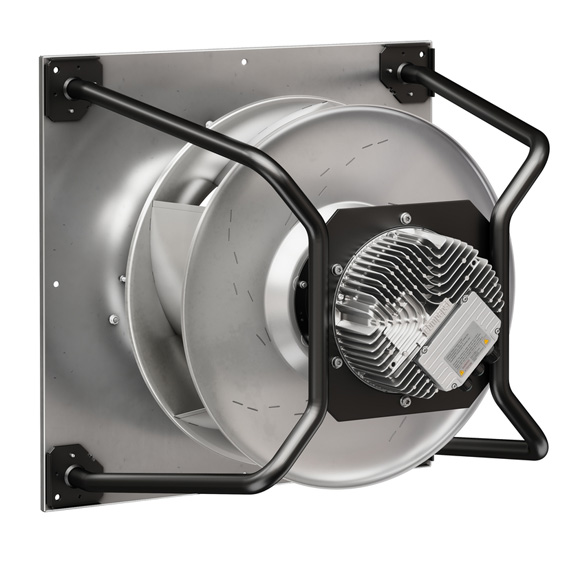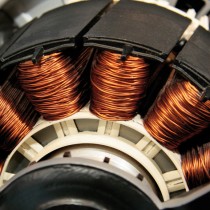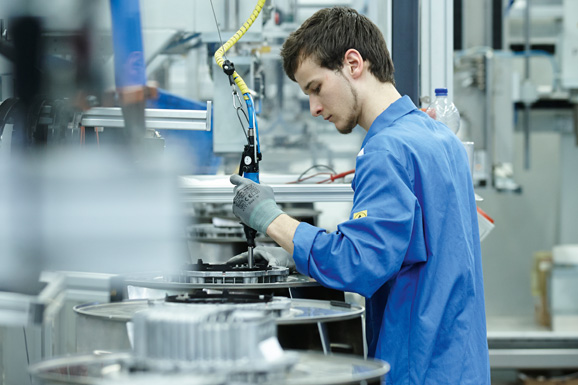The technology involved with centrifugal fans for air handling units is constantly being enhanced – and not without good reason, given that users are demanding ever higher standards in terms of control and energy efficiency. Legal stipulations such as the EnEV (Energy Conservation Regulation) and the EVPG (Energy-related Products Act), known in Germany as the Ecodesign regulation, have greatly increased awareness in this respect (refer to “Ecodesign” box on Page 7). At the same time, economic considerations are also an important factor in the light of the rising cost of energy. After all, the higher the number of fans in operation, the more there is to be gained from energy efficiency.
Continuous improvement process

Fig. 1: The new-look RadiPac. The modification work mainly concentrated on the air inlet into the impeller, the positioning of the external rotor motor in the impeller and the blade profile of the impellers.
ebm-papst, the motor and fan specialists from Mulfingen, have long since been committed to a process of constant improvement which in the final analysis is of equal benefit to both the environment and the financial interests of the customer. For instance, the centrifugal fans of the RadiPac product range (Fig. 1, Page 6) designed specially for use in air handling units have been the subject of ongoing enhancement in recent years, with particular emphasis on energy efficiency, noise reduction and handling properties.
State-of-the-art motors
Consideration was first given to the motors employed. In the case of the external rotor GreenTech EC motors, recent developments have included improvements to the actuation electronics and the use of higher-quality stator plates to increase efficiency. The efficiency levels achieved by the energy-optimised motor, a mains-powered permanently excited synchronous motor (also known as BLDC or PM motor), are already far superior to the values required by efficiency class IE4 as per IEC 60034-30. What’s more, these external rotor motors operate with “simple”, inexpensive and above all readily available ferrites. In other words they are not reliant on potentially problematic rare-earth magnets and yet still manage to attain efficiencies well in excess of 90% (refer to box “No dependence on rare-earth magnets”).
Ecodesign
The Ecodesign regulation for fans (EU 327/2011) specifies minimum efficiency requirements for fans operated by electric motors. The requirements first came into force in 2013 and became more stringent as of 01.01.2015. They apply to all fans with an input power between 125 W and 500 kW. A specified minimum efficiency level has to be attained based on the type of fan concerned. Calculation of the minimum efficiency values is described in this regulation. All GreenTech EC fans in the ebm-papst RadiPac product range far surpass the currently applicable requirements.
The successor: there is always room for improvement

Fig. 2: The results of the optimisation process are impressive. All-in-all, modification of the motor and the flow machine brought about an up to 10% increase in the efficiency of the size 400 RadiPac fan.
This product range is now nevertheless past its prime and – as already planned since 2010 – is being replaced by a successor model designed to set new standards in ventilation technology. The principle of company founder Gerhard Sturm, that every innovation and enhancement should be better than its predecessor, has once again been successfully put into practice. Experience has repeatedly shown that modern EC drives far surpass the conventional AC drives still widely used in air handling and air conditioning systems in terms of energy efficiency. It is however important not to forget that a fan always has to be viewed as a complete system made up of the impeller, motor, control electronics and housing. So the enhancement process has to encompass all aspects – from the electrical connection to the air outlet at the impeller and even the installation situation in the air handling unit – if the energy saving potential is to be used to its best effect (Fig. 2).
No dependence on rare-earth magnets

Fig. 3: External rotor motor with GreenTech EC technology: The rotor moves around the wound stator rather than in it and does not require the use of rare-earth magnets.
In external rotor EC motors, the stationary part of the motor, i.e. the stator and coils, is located on the inside and the moving part, the rotor with the permanent magnets, is on the outside (Fig. 3). The external rotor moves around the internal stator. This arrangement in itself makes it possible to achieve a higher torque (magnet volume, air gap, radius) with an external rotor than with an internal rotor with the same length of core, the same magnet system and the same magnet thickness (reduced magnet volume, reduced air gap, smaller radius). By making clever use of the degrees of freedom in the fan area, an external rotor motor employing hard ferrites can attain torques and levels of efficiency which can only be achieved by an internal rotor with limited degrees of freedom (volume, mass) using rare-earth magnets. As opposed to servo drives, there is no need for fan operation to be highly dynamic. On the contrary, a certain moment of inertia is desirable to obtain smooth start-up and acceleration characteristics. This means that it is no problem for GreenTech EC fans to manage without rare-earth magnets and use can instead be made of ferrites which are not just considerably less expensive but are also available at stable market prices on account of their availability.

Leave a comment